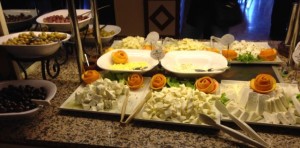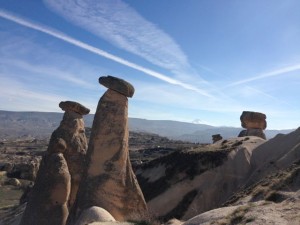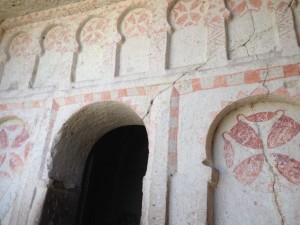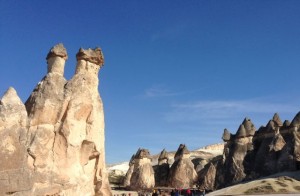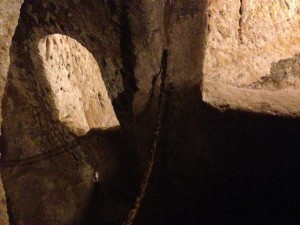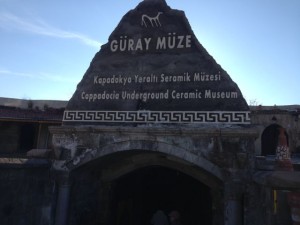I woke to clear skies and went out to see if I could see any balloons in the sky (several of our group had gotten up early
to go ballooning). No balloons and very cold. As I went down to breakfast, I spotted this brazier used as a decoration in the stairway, and it made me think of what might have been used to heat the Caravanserai in winter.
 Our options at breakfast this morning included egg rolls and spaghetti (something to please everyone).
Our options at breakfast this morning included egg rolls and spaghetti (something to please everyone).
The cheese bar was beautifully presented as always.
The sun caught the side of the mountain just as two balloons came into view.
We don’t leave until 9:30 this morning, so I had time to do two small watercolors of the Aegean as we descended Mt. Ida.
This area has been inhabited since the Hittite period from 1800-1500BC. The Hittite raised horses, and Cappadocia means land of beautiful horses. Our first stop is the ‘Three Beauties,” a formation of three chimneys with rocks balanced at the top. The strong winds erode away the soft tufa, leaving these mushroom shaped chimneys. Both Ellie and I did quick watercolors of the Three Beauties.
Tourism here began in the 60s with a French Club Med, and tourism has exploded in last 20 yrs, growing by 10% per year.
Our second stop is a viewpoint over the Valley of Pigeons that gets its name from the many pigeon rooms carved into the rock face of the valley. Because the soil is weak, villagers carved out large caves for pigeons and fed them so they could collect the droppings.
We saw our first of several blue eyed trees decorated with the Turkish symbol to ward off he evil eye.
Cappadocia is best known for its churches and dwellings carved out of the soft tufa rock by the early Christians, who came here to practice secretly after Domitian declared the death penalty for Christians. Many of the apostles traveled through here, as did the Silk Road merchants and the Crusaders. Many of these caves are still occupied today or have been turned into restaurants or boutique hotels.

The Churches of Goreme were carved in the 1st century AD.
In the Iconoclastic period, from 750 AD, images of people were destroyed and symbolism became very important. We visited the Church of St, Barbara, the Church of the Serpent, and the Church of the Buckle. No one is allowed to take pictures inside the churches because the frescoes can be damaged by flash, but I bought several postcards showing the interiors and we could photograph the exterior of the structures.
 The churches and rooms were very small, holding no more than 10-20 people.
The churches and rooms were very small, holding no more than 10-20 people.
This table and benches carved out of tufa in the dinning room sat 40 people.
In 330, when Consantine made Christianity legal, this area became a teaching center.
These structures were occupied until 1928 when the Turkish and Greek government agreed upon exchanging populations that had been cut off by the new boundaries drawn up after WW1 (previously, it had been the Ottoman Empire). Ethnic Greeks and Turks could register their holdings, emigrate to the country of their ethnic origin and be reimbursed by the government for what they left behind. At that time, the Greek Orthodox community of Cappadocia emigrated to Greece. Unfortunately, the local people defaced the frescoes because Islam does not allow the representation of the human form.
A few hundred feet down the mountain is the Church of the Buckle, the oldest and largest of the churches of Goreme and one filled with frescoes with brilliant blue backgrounds.
As we drove away from Goreme, we saw some of the beautiful horses the region is named for.
The Valley of Selve has some of the tallest fairy chimneys and also a 1st century church. Ellie and I did more art in our 20 min stop.
We stopped for lunch at a modern recreation of a caravanserai, meticulously recreated.
In the village of Ozkonak, we explored an underground city discovered in 1972 by a local farmer who lost his sheep but could hear it underground. This hideaway could accommodate several hundred villagers who needed to hide from successive raiders beginning in the 7th century with Arabs raiders through the 13th century when the Crusaders came through. Nothing shows on the surface, but underground, there are storage rooms and tunnels connecting to other rooms and still more tunnels where wheels could be rolled across the opening of the tunnel.
We explored tunnels with three separate wheels that provided many levels of defense.
The villagers also used the underground city for storage of root crops and as a winery.
Grapes would be crushed in the compartment to the right and the juice would run out through the hole to the left.
Our last stop was at the Gurey Ceramics Museum, a ceramics factory that has been owned by the same family for six generations and that houses a remarkable collection of early pottery.
On the way back to our hotel, I snapped a photo of typical architecture using dark and light tufa stone inlays.





